Tenga Goken - Episodes of Samurai Swords
Dojigiri Yasutsuna (blade Length 80 cm, curvature 2.7 cm)
Dojigiri Yasutsuna, known as a sword that belonged to Minamoto no Yoritomo, has an anecdote that he slayed Shuten Doji (a boss of the ogres believed to live in the Mount Oe) with it. This sword, estimated to have been built at the end of the Heian period, had been inherited in the Asikaga Shogun clan as a treasure sword, and its owner crossed to and from Oda Nobunaga at the time of the 13th Shogun, Yoshiteru, Toyotomi Hideyoshi, to Tokugawa Ieyasu. The Dojigiri ended up not being used in a battle; however, the cutting quality later had been proven by cutting six corpses in halves in the Edo period.

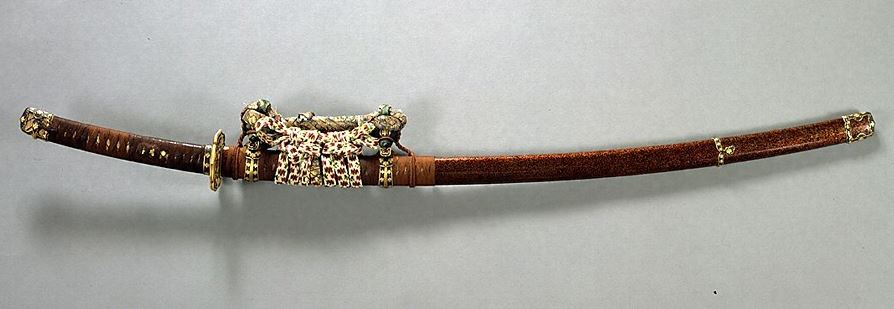
Odenta Mitsuyo (blade length 66.1 cm, curvature 2.7 cm)
Odenta Mitsuyo is short in blade length and wide in width compared to other regular katana sword. When the lord of the Kaga domain, Maeda Toshiie, borrowed the sword from the 2nd Shogun, Tokugawa Hidetada, Toshiie’s daughter recovered from serious illness; therefore the sword was bestowed to the Maeda clan as a treasure sword. It is recorded that when Yamada Asaemon tested the sword, it was able to cut off two bodies and halfway at the backbone of the third body. The sword we see today has a black leathered mounting in a style called Onimaru koshirae, which the 2nd lord, Maeda Toshitsune, ordered to manufacutre.

Mikazuki Munechika (blade length 80 cm, curvature 2.7 cm)
It is said to be the most beautiful sword among Tenka Goken (the five greatest swords). From numbers of temper patterns shaped like a crescent on the blade, it has been nicknamed Mikazuki (crescent moon). It has a steep blade inclination with the narrow tip and the wide hilt side, and is curvy on the hilt side while the tip forms a straight line, which are characteristics to swords manufactured during the Heian period. Created by a skilled swordsmith, Sanjo Munechika, who lived in Yamashiro Province (Kyoto) during the Eien era (987-989).


Juzumaru Tsunetsugu (blade length 81.08 cm, curvature 3 cm)
Known as the Nichiren’s Buddhist monk sword. When Nichiren founded a temple, Kuon-ji, on Mount Minobu, he was given the sword by his adherent for self-protection, and always carried it as a representation of assailing heresy and revealing truth, and on the hilt, he would hang his prayer beads or juzu, which Juzumaru was named after. This magnificent sword is crafted by a swordsmith from the Bicchu Province, Aoe Tsunetsugi.
Onimaru Kunitsuna (blade length 85.2 cm, curvature 3.3 cm)
The Hojo clan’s treasure sword considered to ward off evil spirits. Onimaru Kunitsuna, which is said the ideal form of sword of the Kamakura era, has a significant curve and gradually narrows toward the tip, and its core also has a curve inside the handle. In the Onimaru style, a hilt and case are wrapped with leather strings, and the style is also called Onimaru koshirae.


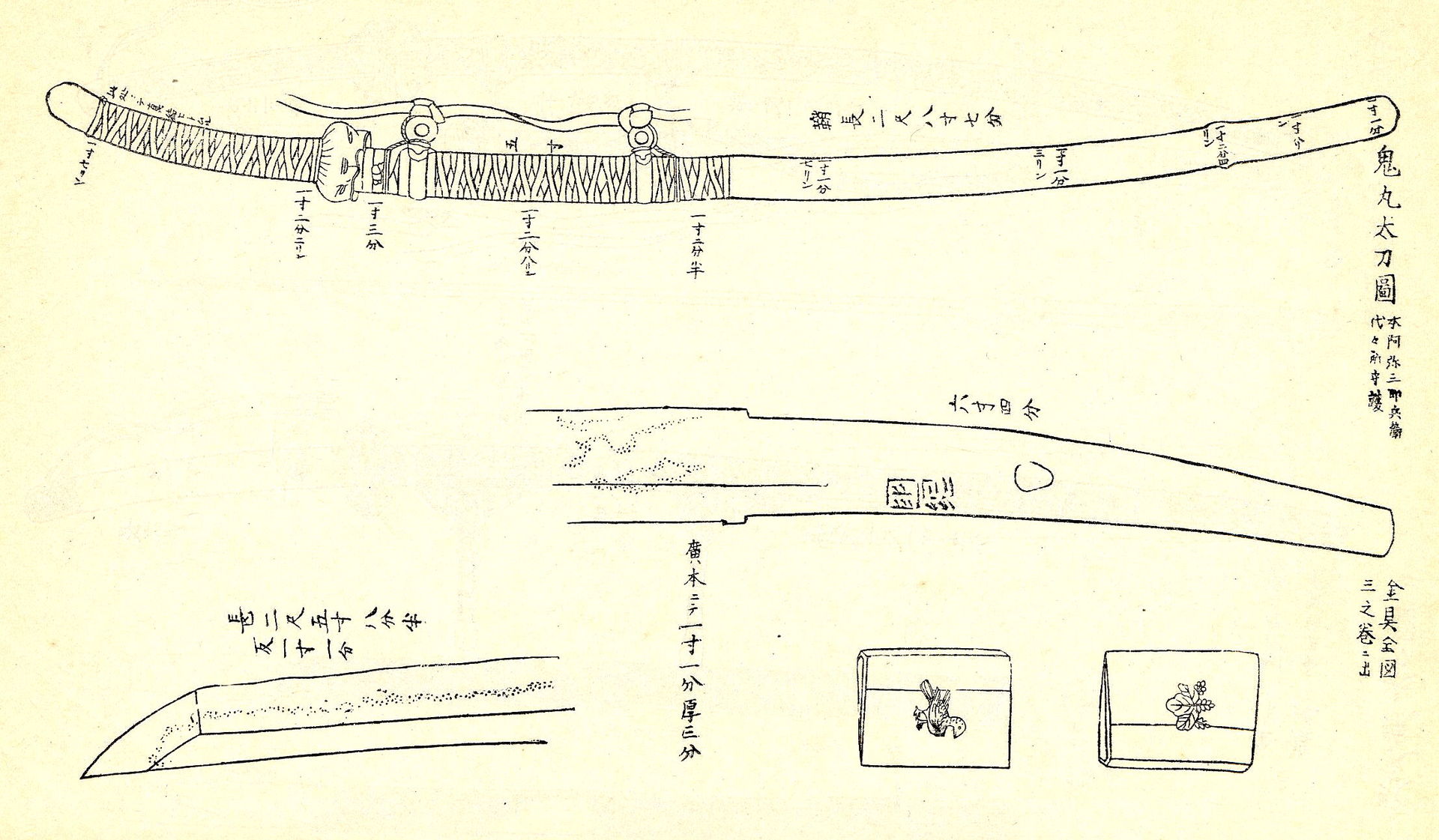
The basic understanding of Katana
The difference between katana and tachi
Tachi are used on horseback, while katana are used on foot. During the Muromachi period, most battles were fought on horseback, so during this period tachi were the primary swords. However, after the Muromachi period, battles on foot became more common, so katana came to prominance.
Tachi and katana are affixed to the body in different ways. Tachi are hung with the blade facing downward from the "koshiobi," a type of sash worn about the waist. Therefore, we use the Japanese verb "haku," which refers to wearing something on the lower body. In the late Heian period, tachi developed their unique shape, and swords from this point on are considered traditional Nihonto, Japanese swords.
On the other hand, katana are carried by inserting the scabbard into the koshiobi, so we use the verb "sasu" instead of "haku." Katana can also be referred to as "uchi-gatana."
Because of this difference in the way one affixes swords to ones body, if we had the scabbards of old swords, we would be able to distinguish them quite easily. However, there are very few original sword koshirae (dressings such as the scabbard and hilt) left behind from old times. Therefore, we must direct our attention to inscriptions on the blade's handle, or "nakago."
Generally, since tachi are worn on the left side with the blade facing downward, the left-hand side of the nakago in this position is facing away from the body. This outer-facing portion is called the "haki-omote." Swordsmiths generally put inscriptions on the outer side of the nakago, so if the swordsmith's name is located on the haki-omote, we consider the sword a tachi. Conversely, the left-hand side of the nakago when the blade faces upward is called the "sashi-omote," so when the inscription is located here we consider the sword a katana.
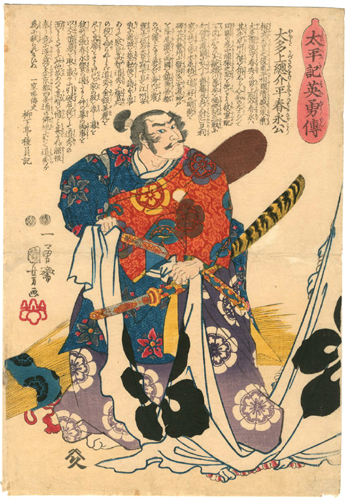
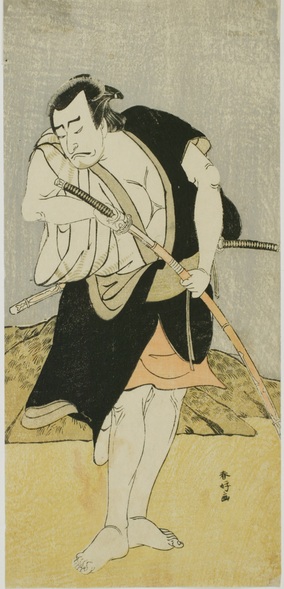
left: tachi and wakizashi, right: katana (uchi-gatana)
The difference between wakizashi and tanto
The term "wakizashi" refers to blades between one and two shaku long (30.3cm-60.6cm), and they are classified as either "o-wakizashi" (about 58cm), "chu-wakizashi (about 46cm), or "ko-wakizashi" (36cm). Tanto are less than 30cm long and have no "shinogi-zukuri," or ridge along the blade.
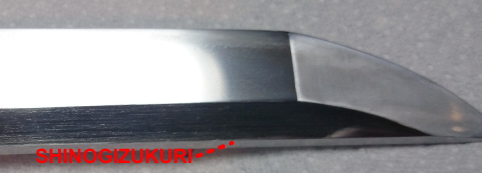
Hamon
The grains that make up the "hamon," or temper pattern along the blade, are classified as either "nioi" or "nie." Extremely fine grains that cannot be distinguished by the naked eye are called nioi, while coarse grains that look something like silver dust are called nie. Furthermore, hamon are broadly classified based on their general shape. Straight patterns are called "suguha," while irregular patterns are called "midareba."

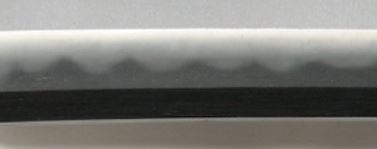

left: midareba, right: suguha
Kogarasumaru - Tachi

The Kogarasu Maru is estimated to have been crafted during the mid-Heian period, when Japanese swords were changing from a straight style to a curved one, and is seen as a valuable resource in understanding their evolution. Unlike typical Japanese swords, it possesses a distinctive shape in that more than half of the sword, starting from the tip of the blade, is double-edged. It was handed down as a sword for protecting the Imperial family, but was given to Taira no Sadamori to mark his status as general in quelling the rebellions of Taira no Masakado and Fujiwara no Sumitomo. From then on, it was passed down as a treasured sword of the Taira clan. The Kogarasu Maru disappeared along with the Taira clan after the Battle of Dan-no-ura in 1185, until the Edo period, when it came to be known that the sword had been handed down by the Iseya. Ultimately, it was presented to Emperor Meiji. Legend states that because it has a crow hilt, it came to be called the Kogarasu (small crow) Maru.
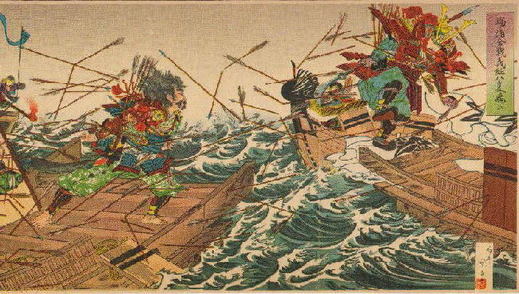
Awataguchi Ikkanshi Tadatsuna - Katana

In 1784, this sword was used in a slashing incident. Sano Senzaemon, who was employed as a guard, slashed at Tanuma Okitomo, a wakadoshiyori (a responsible position in the Edo shogunate). Senzaemon was arrested, and Okitomo died two days later. The incident was a result of Senzaemon's resentment at not being given favors by Okitomo, despite having given him bribes. However, rice prices, which at the time were rising steeply, suddenly experienced a sudden drop, and the common people were suddenly able to buy rice. They believed this to be thanks to Senzaemon and began to worship him as the god of world reformation. (The actual reason for the price drop was that Okitomo's father indicated he would be sending rice from his region to Edo.)
The Awataguchi Ikkanshi Tadatsuna, which had been the sword of the god of world reformation, gathered a great deal of attention, and its value soon rose. Near the end of the Tokugawa shogunate, it became the sword of Ii Naosuke.
Ii naosuke
A hereditary daimyo in the closing days of the Tokugawa shogunate. He was the 15th daimyo of Hikone. He served as Tairō for the Edo shogunate and signed the Harris Treaty with the United States, opening Japan to the world and leading to its modernization. Wielding the power of the state, he purged those who opposed him, but was assassinated in retaliation.
Tsurumaru Kuninaga - Tachi

Of the four extant swords crafted by Heian period swordsmith Kuninaga, the most well-known is Tsurumaru. It was lost once during the Kouan War. However, it was tracked down by Hōjō Tokisada. During the Momoyama period, it came into the hands of Oda Nobunaga who granted it to Mimaki Kambei. At that point, the sword's history was unknown. Some time later, Kambei's grandchild requested an appraisal of the sword from Honami Koutoku, who told him that it was Tsurumaru, formerly passed down by the Hōjō family. At once, word spread that a sword of legend had been found.
In 1703, it was purchased by the Date clan, who began to pass it down after performing extravagant work on it. In 1877, it was presented to Emperor Meiji.
the Koan War
In 1281, the Mongols invaded Hakata. They numbered nearly 140,000, but were destroyed due to the counterattack of the Japanese forces and a chance windstorm.
Koryu Kagemitsu - Tachi


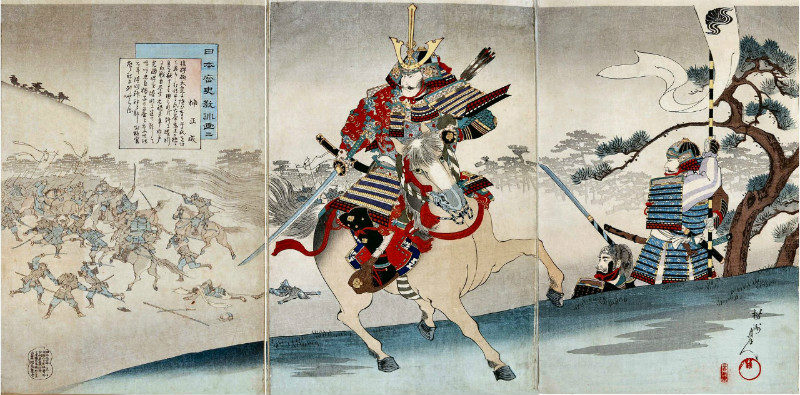
Koryu Kagemitsu is a tachi sword made by swordsmith Kagemitsu in Bizen Province (Okayama prefecture) during the Kamakura period. It belonged to Kusunoki Masashige, who fell fighting for Emperor Go-Daigo. The sword draws its name from the relief of a dragon on the right side. After the tang was shortened, the hilt started to conceal the dragon, so that only its head appears to be peaking out. Kusunoki Masashige did not let go of the sword until he died in battle. Afterwards, it was given to Tokugawa Ieyasu by Toyotomi Hidayoshi. In the late Edo period, Yamada Asaemon came into possession of the sword, which was later presented to Emperor Meiji by the Yamada family.
Kitsunegasaki Tametsugu - Tachi
Kitsunegasaki is a tachi sword crafted by swordsmith Tametsugu in Bizen Province between late Heian and early Kamakura period.
In 1180, after clashing with the Taira at the Battle of Ishibashiyama, Minamoto Yoritomo retreated to Shitodo Cave. After 5 days in hiding, he was found by Taira samurai Kajiwara Kagetoki who switched sides instead of capturing him. Yoritomo went on to seize control of the country and establish the Kamakura shogunate and appointed Kagetoki as his chief vassal. However, despite having gained Yorimoto's trust, Kagetoki slandered political opponents. This was the main cause of the famous Minamoto Yoshitsune's fall. Eventually, Kajiwara was found out and fled towards Kyoto with his retainers but were killed by their pursuer Kikkawa Tomokane at Kitsunegasaki. Tomonake's sword acquired the name Kitsunegasaki.

Ookanehira - Tachi
This large war sword is Bizen Osafune's greatest masterpiece and was handed down to the Ikeda clan. It draws its name from it's huge length, 3 Japanese feet (45 inches). Osafune was a school of sword making established in Bizen Province Okugun, Osafune (currently Setouchi City in Okayama Prefecture) in medieval Japan. Since the school produced many great swordsmiths, Osafune swords are highly valued. Legend has it that Oda Nobunaga's chief vassal, Ikeda Tsuneoki's great-grandson Mitsumasa bought Ookanehira for a large sum of money but said ''What's the use of buying a sword for a lot of money in times of peace''. When asked which is the best Japanese sword, most people will answer either Doujigiri or Ookanehira.


Dai Hannya Nagamitsu - Tachi
This sword made in the Bizen Osafune Nagamitsu style was usually sold for 600 Kan coins during the Muromachi period. Because of this, it was named in reference to the 600 scrolls of the Great Perfection of Wisdom Sutra (the 'Dai Hannya' sutra). At the time, even famous swords didn't sell for more than 100 Kan, so its price was rather extraordinary. This was the sword carried by Ashikaga Yoshiteru, a 13th generation shogun and master fencer who was trained to perfection by Tsukahara Bokuden.
In the Eiroku Incident (1565), Yoshiteru was attacked by the military forces of the Miyoshi Triumvirate and Matsunaga Hisahide until he was cornered in his palace. He pierced the floor with several swords so that, after chipping one and rendering it useless in the process of defeating an opponent, he threw it away and plucked out a new one. Out of all of them, the one he happened to pick as a replacement to continue fighting was precisely the Dai Hannya. Just before dying, and using a tatami mat as a shield, he killed the enemies surrounding him from all directions at the same moment as they killed him.
Tsukahara Bokuden (1489~1571)
He was a swordsman who lived in the latter half of the Muromachi period. He was from Hitachi Province. He was a pioneer of the Shintō-ryū school of kenjutsu. He learnt Shinkage-ryū from Kamiizumi Nobutsuna, traveled to several countries where new schools of fencing had just appeared in order to gain skill in combat, and then became the fencing instructor of the shogun Ashikaga Yoshiteru. He had many other disciples, like Hosokawa Fujitaka and Imagawa Ujizane.

Heshikiri Hasebe - Katana
Oda Nobunaga's two favorite swords were 'Heshikiri Hasebe' and ' Samonji'. On the Heshikiri's tang are two signatures in gold inlay: 'Hasebe Kunishige Honami' on the front, and 'Kuroda Chikuzen no Kami' on the back. Hasebe Kunishige, however, was the swordsmith who made it. Honami Kotoku, on the other hand, was the Sword Appraiser. Kuroda Chikuzen no Kami is another name for Toyotomi Hideyoshi's strategist, Kuroda Kanbei, who was gifted this sword by Oda Nobunaga as an appreciation for his assistance during the assault on the Chūgoku region.
The Heshikiri's name comes from one time when a tea-server who had offended Nobunaga (the tea-server being someone who is in charge of doing odd jobs like welcoming guests into the castle, or boiling water and making preparations to serve tea) escaped and hid under a shelf, until Nobunaga spotted him and pressed down on the shelf with his sword (a move called 'heshikiru' in Japanese) until it broke in two equal parts.


Yoshimoto Samonji - Katana
This sword belonged to Imagawa Yoshimoto, praised as being 'The Best Samurai of the Coast'. Despite it being said that he was peerless, he was killed by Oda Nobunaga in the Battle of Okehazama. After this, it became one of Nobunaga's favorite swords and he even kept its name. On the Samonji's tang is inscribed the date of the 19th of May of the 3rd year of the Eiroku era (12th of June of 1560 according to the Julian calendar), which marks the joy Nobunaga felt when he had killed Imagawa Yoshimoto and held the sword in his hand so strongly that it cut his fingers. After being killed by Akechi Mitsuhide in the incident at Honnō-ji, the sword came into the hands of Toyotomi Hideyoshi and Tokugawa Ieyasu as they came into power. Regrettably, however, it was later burned in the Great Fire of Meireki. It is currently owned by the Kenkun Shrine.

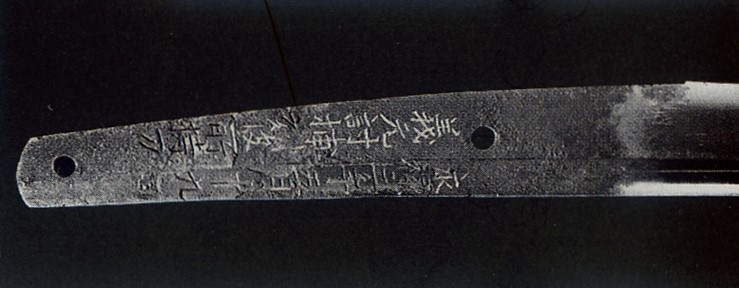
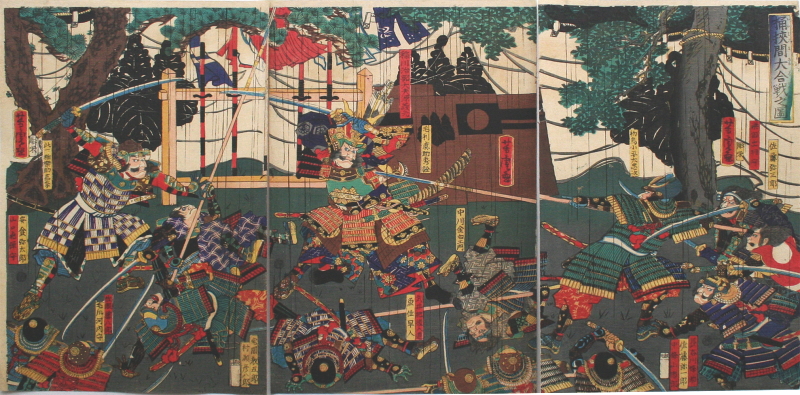
Kasen Kanesada - Tachi
This sword, forged by the skilled artisan Kanesada, was praised as being the absolute best in the whole of the eastern provinces during the Muromachi period. Daimyo in the Warring States period all wanted to lay hands on it. And during the Edo period, Yamada Asaemon acknowledged it as being a 'first-rate sword' based on its sharpness.
Kasen Kanesada was the sword carried by Hosokawa Tadaoki, and even after retiring he used it to slay 36 of his son Tadatoshi's retainers (those who had misbehaved) in order to serve as an example to him. He named the sword as a reference to that number of people, which reminded him of the Thirty-Six Immortals of Poetry (the 'Kasen', which collectively refers to the 36 most renowned poets of the Heian period). Hosokawa Tadaoki is also known for having been Sen no Rikyū's leading disciple.


Fukuoka Ichimonji - Tachi
This was the sword carried by Mōri Motonari, a daimyo whose power extended over the people of Aki Province, and over the whole of the Chūgoku region. He later sent it as an offering to Itsukushima Shrine in Miyajima, Aki.
At the Battle of Miyajima, Mōri Motonari defeated an army of around 30,000 soldiers with only 4000 of his own, and from that point onwards his dominion rapidly expanded. From that moment, Motonari adhered faithfully to Itsukushima Shrine and bestowed it with many precious gifts, one of which was his Fukuoka Ichimonji.
This sword is thought to be the first example of what in the Kamakura period would become the Ichimonji School; whose characteristics were blades with an irregular temper line and a clove pattern (where the blade's temper pattern resembles the outline of a clove flower), much like this present item.


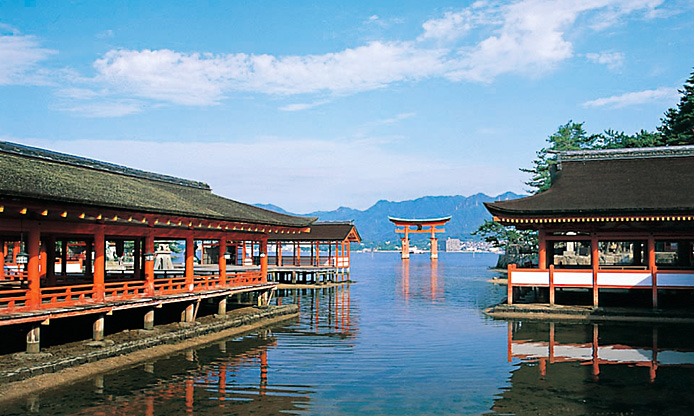
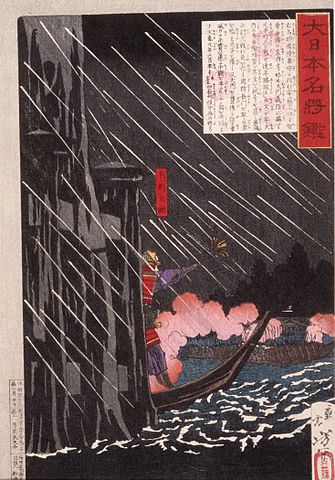
Ishida Masamune - Katana
This sword is unsigned, but thought to be the work of Priest Gorō Masamune.
It was the favorite sword of Ishida Mitsunari, who served as a retainer for Toyotomi Hideyoshi. It is unclear when it received its battlemark, but due to its deep cut on the back of the sword it received the nickname of 'Kirikomi Masamune' ('Notched Masamune').
Mitsunari was on bad terms with Katō Kiyomasa, Fukushima Masanori and other such martial commanders, and after Toyotomi Hideyoshi's death he fell under the attack of seven of these generals.
Mitsunari, who found himself in a tight spot, requested the help of Tokugawa Ieyasu. In exchange for his protection, Mitsunari resigned from his position as one of the Five Commissioners of Hideyoshi's government and returned to his dominion of Sawayama, in the Ōmi Province.
Yūki Hideyasu was the one who escorted Mitsunari as a bodyguard all the way to Sawayama on that occasion. Then, before parting ways, Mitsunari gave his sword, the Masamune, to Hideyasu. It is because of this that the sword came to be known as the 'Ishida Masamune'.

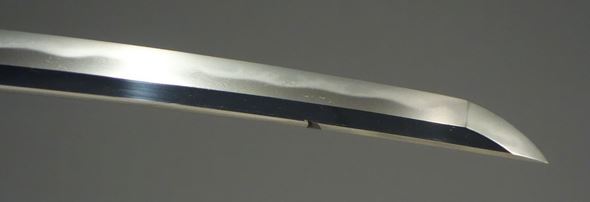
Nikko Sukezane - Tachi

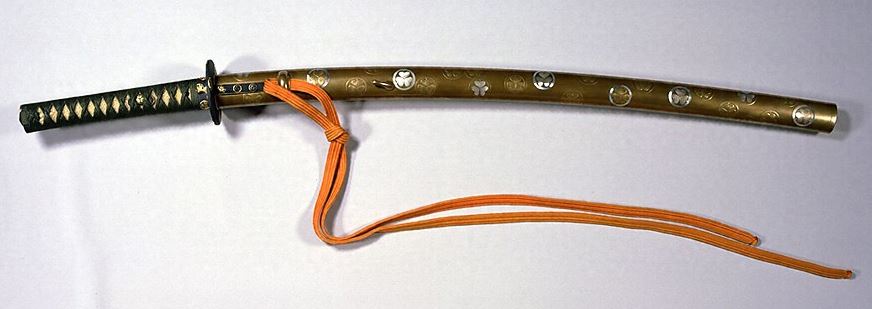

Tokugawa Ieyasu’s favorite sword created by a swordsmith for the Kamakura shogunate, Sukezane of Bizen. As it is stored at Nikko Toshogu, it is also called Nikko Sukezane.
The sword originally belonged to Kato Kiyomasa, and he presented it as his congratulations on his daughter’s marriage to the Tokugawa. Although Kiyomasa suddenly passed away before seeing his daughter as a bride, he would have believed in the peace of the Kato family. Nonetheless, the Kato, who was on the Toyotomi side, became extinct at the second generation by Ieyasu’s siege of Osaka. Ieyasu’s favorite black lacquer of Nikko Sukezane is called Sukezane goshirae (style), which has been numerously copied as an example of a sword style.
Ichigo Hitofuri - Tachi
While Awataguchi Yoshimitsu is regarded as one of the greatest swordsmiths along with Masamune, he created only daggers except this sward; therefore they called it Ichigo Hitofuri (the one and only lifetime sword).
During the Sengoku period, the sword was owned by the Ashikaga shogun family. After Oda Nobunaga drove Ashikaga Yoshiaki out, he remained as a shogun only under the Mori’s protection. Following Oda nobunaga’s death, the Mori surrendered to Toyotomi Hideyoshi, who succeeded the Oda army, and the Ichigo Hitofuri was dedicated to Hideyoshi. As Hideyoshi was short, he had the Ichigo Hitofuri with a blade length of 2 shaku 8 sun 3 bu (applox. 86 cm) shortened to 2 shaku 2 sun 7 bu (approx. 69 cm).
It was handed down in the Toyotomi family after Hideyoshi’s death until the family became extinct, and then it passed into the hands of the Tokugawa family.
The Ichigo Hitofuri was burned in the Great fire of Meireki later on, however, the Tokugawa family had Echizen Yasutsugu swordsmith it again.
The recovered Ichigo Hitofuri was passed to the Tokugawa in Owari province.
Around the end of the shogunate period, in 1863, a lord of Owari province, Tokugawa Mochinaga, offered it to the Emperor Komei. It has been passed on as an imperial property since then.

Nikkari Aoe - Tachi
The sword is said to be attributed to a swordsmith of the Aoe school of Bicchu, Aoe Sadaji. While it was originally 2 shaku 5 sun (approx. 75.75 cm), it was shortened to 2 shaku (approx. 60.6 cm) and then to 1 shaku 9 sun 9 bu (approx. 60.3 cm).
The name is originated from the legend that after it slashed a female ghost who was smiling “nikkari” (a Japanese onomatopeic word that describes a smile), it turned out next morning that a stone pagoda had been cut into two. There is a theory that the samurai who slashed the ghost was one of Asano Nagamasa’s vassals, and the ownership of the sword changed from him to Shibata Katsuie, and then to his son, Shibata Katsutoshi. Furthermore, Niwa Nagahide, who defeated Katsutoshi, dedicated the sword to Toyotyomi Hideyoshi, and his son Toyotyomi Hideyori presented it to Kyogoku Takatsugu.
In Edo period, they said that it was too valuable for a government connoisseur of swords, the Honami, to set a price on.

Tonbogiri - Spear

A spear said to be Honda Tadakatsu’s favorite. It is one of the ultimate spears called the Three Great Spears of Japan.
It is characterized by its sasabo, which literally means wide, long blade as a bamboo leaf.
The name was deprived from a legend that a dragonfly hit on it and instantly cut in half.
The length of the blade measures 43.7 cm, the blade shaft 55.6 cm, the maximum width 3.7 cm, thickness 1 cm, and weighs 498 grams. On the groove of the center of the blade are engraved with Sanskrit characters and a sward with three-pronged handles. Created by Fujiwara Masazane of the Mikawa Monju school.
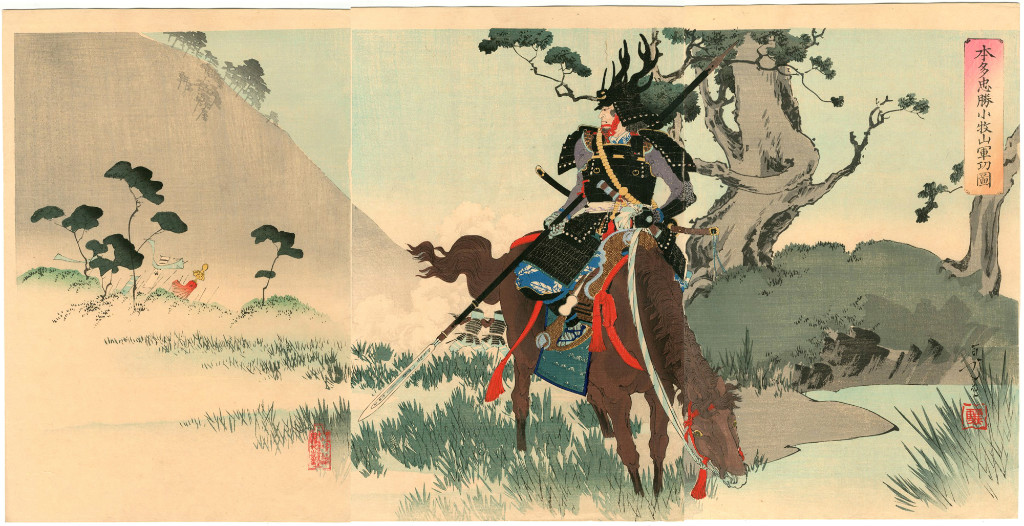
Hocho Masamune - Tanto
Originally the dagger owned by diplomat Ankokuji Ekei of the Mori Clan, who, after the Battle of Sekigahara, Ekei was given shelter by Hashinobo Myoo, son-in-law of Nishi Honganji’s house elder, the Head of the Ministry of Justice for Shimotsuma. This was discovered after it was reported to Okudaira Nobumasa by a monk. Okubaira Nobumasa sent out a search party, and Ekei, riding in the vassal’s palanquin, tried to escape under the guise of being a patient. When the hunter Torii Nobuaki tried to take Ekei prisoner, Ekei took out his Masamune blade and tried to attack, but in the end he was captured after an attack from Torii Nobuaki.
Okudaira Nobumasa took Ekei to Tokugawa Ieyasu, winner of the Battle of Sekigahara, and when he handed over his dagger it was gifted to Nobumasa as a reward.
After that the Masume Knife was passed down through the Okudaira family through Nobumasa’s fourth son Tadaaki (whose mother was Tokugawa Ieyasu’s oldest daughter Kamehime, a grandchild of the Ieyasu family. Okudaira family ware allowed chenge the family name to Matsudaira by Tokugawa, Matsudaira is pre-name of Tokugawa) For his distinguished service during the Battle of Nagashino, Okudaira Nobumasa received as an award a Nagamitsu sword, which has also been passed down through the Matsudaira family.

Monoyoshi Sadamune - Wakizashi
The sword made by Sadamune, son of Masume. It is said that when Tokugawa Ieyasu went into battle carrying this short sword he would always win, so it was named “Monoyoshi (means good thing)”. After Ieyasu’s death, his huge inheritance was split between the three Tokugawa families and some others. However, this wakizashi, being especially valuable, would be expected to be passed on to the second generation through Hidetada. However, according to records, Kame, the concubine who Ieyasu loved in his final years, despite knowing that the masterpiece sword should be handed down to Hidetada, secretly took the sword and gave it to her son Yoshinao (descended from the Owari branch of the Tokugawa clan) before the inheritance was divided up.

